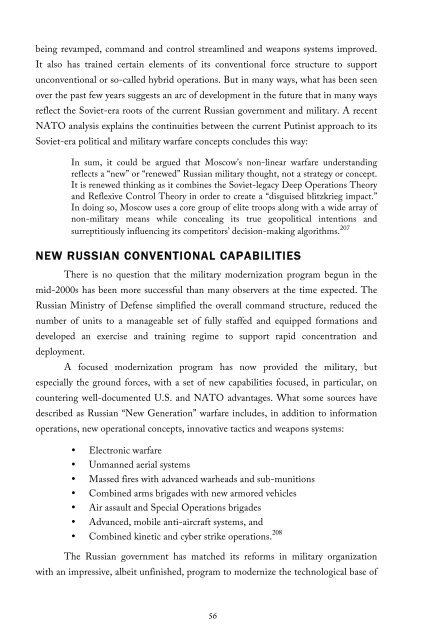You also want an ePaper? Increase the reach of your titles
YUMPU automatically turns print PDFs into web optimized ePapers that Google loves.
eing revamped, command and control streamlined and weapons systems improved.<br />
It also has trained certain elements of its conventional force structure to support<br />
unconventional or so-called hybrid operations. But in many ways, what has been seen<br />
over the past few years suggests an arc of development in the future that in many ways<br />
reflect the Soviet-era roots of the current Russian government and military. A recent<br />
NATO analysis explains the continuities between the current Putinist approach to its<br />
Soviet-era political and military warfare concepts concludes this way:<br />
In sum, it could be argued that Moscow’s non-linear warfare understanding<br />
reflects a “new” or “renewed” Russian military thought, not a strategy or concept.<br />
It is renewed thinking as it combines the Soviet-legacy Deep Operations Theory<br />
and Reflexive Control Theory in order to create a “disguised blitzkrieg impact.”<br />
In doing so, Moscow uses a core group of elite troops along with a wide array of<br />
non-military means while concealing its true geopolitical intentions and<br />
surreptitiously influencing its competitors’ decision-making algorithms. 207<br />
NEW RUSSIAN CONVENTIONAL CAPABILITIES<br />
There is no question that the military modernization program begun in the<br />
mid-2000s has been more successful than many observers at the time expected. The<br />
Russian Ministry of Defense simplified the overall command structure, reduced the<br />
number of units to a manageable set of fully staffed and equipped formations and<br />
developed an exercise and training regime to support rapid concentration and<br />
deployment.<br />
A focused modernization program has now provided the military, but<br />
especially the ground forces, with a set of new capabilities focused, in particular, on<br />
countering well-documented U.S. and NATO advantages. What some sources have<br />
described as Russian “New Generation” warfare includes, in addition to information<br />
operations, new operational concepts, innovative tactics and weapons systems:<br />
• Electronic warfare<br />
• Unmanned aerial systems<br />
• Massed fires with advanced warheads and sub-munitions<br />
• Combined arms brigades with new armored vehicles<br />
• Air assault and Special Operations brigades<br />
• Advanced, mobile anti-aircraft systems, and<br />
• Combined kinetic and cyber strike operations. 208<br />
The Russian government has matched its reforms in military organization<br />
with an impressive, albeit unfinished, program to modernize the technological base of<br />
56



